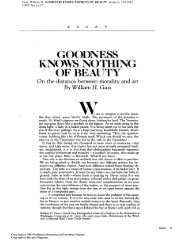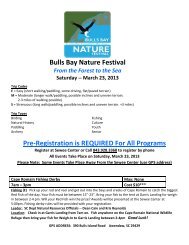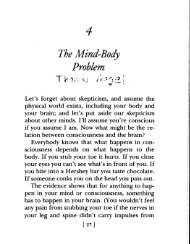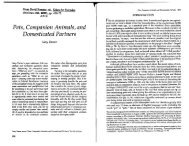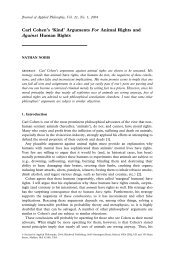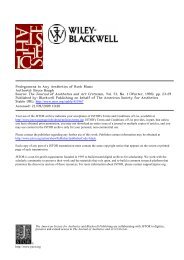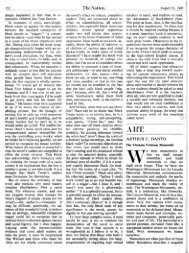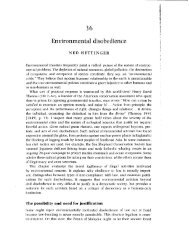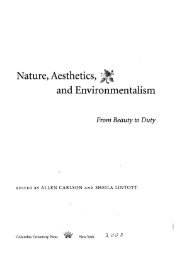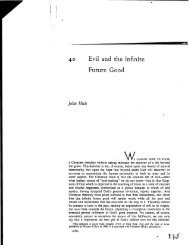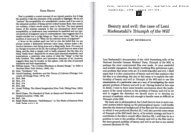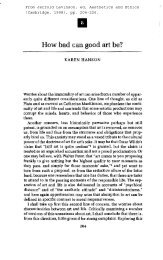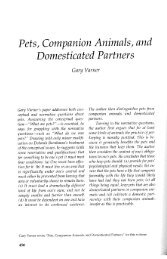Evaluating Positive Aesthetics - Ned Hettinger
Evaluating Positive Aesthetics - Ned Hettinger
Evaluating Positive Aesthetics - Ned Hettinger
You also want an ePaper? Increase the reach of your titles
YUMPU automatically turns print PDFs into web optimized ePapers that Google loves.
Introduction<br />
<strong>Evaluating</strong> <strong>Positive</strong> <strong>Aesthetics</strong> 1<br />
<strong>Positive</strong> aesthetics (=PA) is the view that all of nature is beautiful. More precisely, it is<br />
the idea that nature–to the extent it is not influenced by humans--is specially and predominantly<br />
beautiful. John Muir, the naturalist founder of the Sierra Club, was one of the first to embrace<br />
the doctrine claiming that “None of nature’s landscapes are ugly so long as they are wild ” (1901,<br />
th<br />
p. 4). Although its roots are in 19 century romantic attitudes toward nature, PA appeals to<br />
contemporary environmentalists who want to protect wild nature from the human onslaught. If<br />
we assume (as is plausible) that human-manipulated environments and constructed objects are<br />
not specially and predominantly beautiful, then PA gives us strong aesthetic reasons for<br />
protecting nature.<br />
Some of the most prominent figures in environmental ethics and aesthetics have defend<br />
PA. Holmes Rolston, III, a founder and leading figure in the field was an early proponent:<br />
The Matterhorn leaves us in awe, but so does the fall foliage on any New England<br />
hillside, or the rhododendron on Roan Mountain. Those who linger with nature<br />
find this integrity where it is not at first suspected, in the copperhead and the<br />
alligator, in the tarantula and the morel, in the wind-stunted banner spruce and the<br />
straggly box elder, in the stormy sea and the wintry tundra. . . . This value is often<br />
. . . aesthetic and invariably so if we examine a natural entity at the proper level<br />
of observation or in terms of its ecological setting. The ordinary rock in<br />
microsection is an extraordinary crystal mosaic. The humus from a rotting log<br />
supports an exquisite hemlock. . . . Should we say that we find all life beautiful<br />
(1986/1979, pp. 44-45)?<br />
Allen Carlson, the leading figure in environmental aesthetics, advocated PA in one form or<br />
another for over twenty years (before rejecting it in his latest book). His first formulation was<br />
1<br />
I need and want to thank ____________ for significant help with the ideas in this paper.<br />
1
this:<br />
The natural environment, in so far as it is untouched by humans, has mainly<br />
positive aesthetic qualities; it is graceful, delicate, intense, unified, orderly, not<br />
dull, bland, insipid, incoherent, chaotic. All virgin nature in short is essentially<br />
aesthetically good. The appropriate or correct aesthetic appreciation of the natural<br />
world is basically positive and negative aesthetic judgments have little or no<br />
place” (2000/1984, p. 72).<br />
Gene Hargrove, the founder and editor of the journal Environmental Ethics, argues that nature’s<br />
purposeless creativity insures that “nature is always beautiful and never ugly” because whatever<br />
is created in that way “always brings with it compatible standards of goodness and beauty. Put<br />
another way, nature is itself its own standard of goodness and beauty, making ugliness<br />
impossible as a product of nature’s own creative activity” (1989, p.184). 2<br />
The idea that all of nature is beautiful is initially as implausible as is the claim that all art<br />
is beautiful. As Stan Godlovitch puts it, “Just as there are rotten violinists, so there must be<br />
pathetic creeks; just as there is pulp fiction, so there must be junk species, just as there are<br />
3<br />
forgettable meals, so there must be inconsequential forests” (1998-1). As examples of ugly<br />
nature, consider diseased, crippled, or injured animals. Or imagine the aroma of a rotting<br />
carcass, the harsh squawk of a grackle, the slimy feel of an eel, or the taste of a rotten tomato.<br />
Given the intuitive implausibility of PA, it is not surprising that a number of environmental<br />
2<br />
Other environmental philosophers who have embraced PA include Robert Elliot [“I endorse . . . ‘positive<br />
aesthetics’; namely, the view that all natural objects have aesthetic value” (1997, p. 61)], Janna Thompson [“The<br />
idea that all of nature, above all, wild nature, should be judged to be beautiful is extremely appealing, and not one<br />
that I want to dispute” (1995, p. 296)], Glenn Parsons [“the essential and universal beauty of nature is not a dubious<br />
idea that we must argue for based on whatever our conception of appropriate aesthetic appreciation happens to be,<br />
but rather part of the intuitive data that we use in constructing our theories of appropriate aesthetic appreciation of<br />
nature” (2002, p. 294)]–though he has more recently rejected the doctrine, and John Fisher (2010), who defends PA<br />
for wild animals considered as a member of the species they are.<br />
3<br />
Godlovitch is not endorsing this claim<br />
2
aestheticians have rejected the doctrine. Malcolm Budd, for example, argues that<br />
An adherent of the view that a natural thing cannot possess a negative aesthetic<br />
quality would need to show that none of the ways in which organisms can be<br />
defective instances of their kinds could be manifest in their appearance in such a<br />
way as to display a negative aesthetic quality. It does not seem possible to<br />
establish this (2002, p.126).<br />
Emily Brady argues that it is “naive and idealistic” to think we can “always eliminate negative<br />
aesthetic value” and argues that PA is an “incomplete environmental aesthetics, risking an<br />
attitude which ignores the true diversity of characteristics possessed by various<br />
natural environments and animals” and “impoverishes” our experience of them (2010. p. 14).<br />
Marcia Eaton argues that those who claim that “nothing in nature can be ugly. . . go too far” and<br />
thinks there are “some obvious examples of ugly natural objects” citing not only deformed<br />
animals and plants, but “ugly shells . . . left behind as shellers gather the ones they prefer” after<br />
rejecting those that are “unattractive or unappealing”(2005, pp. 47-48). Yuriko Saito also rejects<br />
the idea that all of nature is aesthetically appreciable arguing that some natural events are too<br />
psychologically disturbing to allow for aesthetic appreciation and that moral concerns should<br />
prevent us from appreciating natural events that cause great suffering to humans (1998).<br />
This paper identifies various versions of PA, assess their plausibility, and evaluates the<br />
cogency of arguments for them. I set out four conditions for an adequate PA:<br />
(1) It must accommodate the existence of negative aesthetics in nature,<br />
(2) It must not apply to the rest of the world, including the artworld and human<br />
environments (nature should turn out to be specially beautiful),<br />
(3) It should depend on the actual contingent characteristics of nature, rather than being<br />
stipulated a priori or defended on conceptual or theoretical grounds, and<br />
3
(4) It must be a doctrine useful for conservation of nature.<br />
I am generally supportive of PA and believe that a holistic, knowledge-infused version along the<br />
lines articulated by Holmes Rolston does the best job of meeting these requirements. The idea<br />
that nature is specially and predominantly aesthetically positive has a good deal of plausibility.<br />
Easy Beauty, Knowledge and PA<br />
PA is useful in combating a prevalent and harmful tendency in nature appreciation toward<br />
“easy beauty.” One example of the lazy preference for easy beauty is the “scenery cult,” a type of<br />
nature appreciation that limits itself to “nature’s show pieces”(Saito, 1998) (e.g., the Grand<br />
Canyon) and finds “the scenically-challenged” (Saito, 1998) parts of nature (e.g., plains and<br />
deserts) boring. In response, advocates of PA argue that such landscapes have a subtle, beauty<br />
that can and should be aesthetically appreciated. With Aldo Leopold they point out that “In<br />
country, as in people, a plain exterior often conceals hidden riches” (1966/1948, p. 276). The<br />
insistence on easy beauty is also manifest in a preference for cute animals like panda bears and a<br />
dislike for the more difficult and superficially unattractive species like bats or snakes. Similarly,<br />
this insistence on easy beauty leads the appreciator to ignore the subtle aesthetic value in a drab<br />
tundra plant in favor of the dramatic beauty of a giant sequoia.<br />
An important argument in favor of PA is that as we learn more about nature or natural<br />
items, we find more to appreciate. According to Rolston, beauty in unscenic nature<br />
is not so much viewed as experienced after one reaches ecologically tutored<br />
understanding. It is not so much a matter of sight as of insight into the drama of<br />
life. In many of life’s richest aesthetic experiences there is nothing to put on<br />
canvas, nothing to take snapshots of (1988, p. 241).<br />
PA is thus typically allied with a cognitive focus in the aesthetics of nature whereby knowledge<br />
4
of nature can improve our appreciation of it. In the case of nature, knowledge tends to<br />
4<br />
undermine negative aesthetics. It can transform the boring and the ugly into something<br />
aesthetically valuable. For example, the monotonous prairie becomes the one time home of<br />
thundering herds of bison, and once informed that it is 100 years old and withstands 80 mph<br />
winds and 30 degrees below zero winter temperatures, the drab tundra plant becomes a stalwart<br />
centurion. Similarly, with the right knowledge, the hideous vampire bat becomes a marvelous<br />
sonar flying machine. Knowledge of natural history--supported by imagination and emotion<br />
based on such knowledge and integrated into the aesthetic experience--allows for the aesthetic<br />
appreciation of natural items that might otherwise seem aesthetically negative or neutral.<br />
Leopold is perhaps the best at integrating knowledge into the aesthetic appreciation of nature:<br />
Our appreciation of the crane grows with the slow unraveling of earthly history.<br />
His tribe, we now know, stems out of the remote Eocene. The other members of<br />
the fauna in which he originated are long since entombed within the hills. When<br />
we hear his call we hear no mere bird. We hear the trumpet in the orchestra of<br />
evolution. He is the symbol of our untamable past, of that incredible sweep of<br />
millennia which underlies and conditions the daily affairs of birds and men<br />
(1966/1947).<br />
Does knowledge about nature, supplemented by appropriate imaginative and emotional<br />
response, do away with all negative aesthetics of nature? Yuriko Saito suggests one way that it<br />
might, arguing that there are always scientifically-interesting accounts that can make any natural<br />
phenomenon appealing:<br />
I cannot think of any stories of nature that are uninteresting or trivial. . . No matter<br />
how seemingly insignificant, uninteresting, or repulsive at first sight, natural<br />
history and ecological sciences reveal the marvelous works of every part of nature.<br />
. . every part of nature is aesthetically positive for its storytelling power (1998, p.<br />
4<br />
This is not true in general about bad art or ugly humanized environments. In these case, it is often true<br />
that the more we learn, the more we have reasons for finding these objects aesthetically negative.<br />
5
105).<br />
Here I think it helps to distinguish between two types of counter examples to PA in nature: the<br />
boring (which can be merely aesthetically neutral) and the ugly (which is positively negative).<br />
I’m inclined to accept that knowledge of nature (emotionally and imaginatively integrated with<br />
perception) will invariably turn tedious, aesthetically neutral nature into something aesthetically<br />
positive, though I’m skeptical that the resulting value will be so positive in all cases that we<br />
would marvel at it (as Saito’s language suggests).<br />
With ugly nature, however, the addition of an interesting scientific (or other?) story<br />
integrated into the perceptual experience does not necessarily do away with (or outweigh) the<br />
6<br />
negative aesthetics involved, although it can. Emily Brady uses the example of a scab on<br />
human skin: “The scab is ugly, evidence of a wound, and although part of a healing process with<br />
positive value, this doesn’t convert the scab itself into something beautiful” (2010, p. 4).<br />
Understanding how organisms can repair their wounds and that the scab is an essential part of<br />
this healing process is the kind of account that can promote a positive aesthetic response.<br />
Whether or not it does in this case is not clear to me. Several things can happen in cases such as<br />
this: (1) Conversion of the negative aesthetic quality into a positive one; (2) A weakening of the<br />
negative aesthetic quality (for example, perhaps a bog stinks less badly when we understand the<br />
smell is of decaying plants returning nutrients to the soil, a recycling process that is essential to<br />
healthy ecosystems and flourishing life on earth); (3) Addition of positive aesthetic dimensions<br />
5<br />
I do not think an analogous case can be made for the claim that additional information will turn boring<br />
artworks or monotonous track housing into aesthetically positive human artifacts. In part this is because we will<br />
often discover that inept or morally dubious behaviors underlie the aesthetically negative products of humanity.<br />
6<br />
My discussion here owes a lot to Emily Brady’s (2010) paper “Ugliness and Nature.”<br />
6<br />
5
that may or may not outweigh the negative dimension that remains. It is not easy to distinguish<br />
which of these is taking place.<br />
Problematic versions of PA: No Negative Judgment and Equal Beauty<br />
I now discuss and reject what I consider to be two clearly problematic versions of PA:<br />
The “no negative aesthetics judgment thesis” and the “equal beauty thesis.”<br />
According to the no negative judgment thesis, negative aesthetic judgments about nature<br />
are not possible. Carlson in his first formulation of PA claims the following: “The appropriate<br />
or correct aesthetic appreciation of the natural world is basically positive and negative aesthetic<br />
judgments have little or no place” (2000/1984, p. 72). One important class of negative<br />
judgments about nature’s aesthetic value is clearly ruled out, and perhaps this is what Carlson<br />
had in mind. As Malcolm Budd puts it, nature “is immune to all the defects to which art is liable<br />
in virtue of being the product of intelligent design” (2002, p. 98). Nature can’t be trite,<br />
sentimental, crude, derivative, or shoddy–as can artworks or other objects of human design,<br />
because nature was not designed. In short, the argument is that because there is no design in<br />
nature to critically assess, then no negative aesthetic judgments of nature are possible.<br />
This argument problematically assumes that aesthetic evaluation must assess design. Not<br />
only is this claim false–pleasing shapes and colors can be aesthetically appreciated independently<br />
of any considerations about their being designed–but it also makes positive aesthetic evaluation<br />
of nature impossible. Some have argued for this very reason (viz., that nature is not designed)<br />
7<br />
that nature appreciation is not aesthetic. But we can dismiss this view not only because if flies<br />
7<br />
For example, Robert Elliot once argued that “an apparently integral part of aesthetic evaluation depends<br />
on viewing the aesthetic object as an intentional object, as an artifact, as something that is shaped by the purposes<br />
and designs of its author.” On whether responses to nature are aesthetic, he says, “I agree that they are not.”<br />
7
in the face of the fact that nature appreciation is a paradigm of aesthetic appreciation, but also<br />
because it is clearly useless as support for PA for nature. The argument for rejecting negative<br />
aesthetic judgment about nature based on its lack of design seems unsupportable.<br />
The “equal beauty thesis” should also be rejected. Differential aesthetic judgments of<br />
natural items are commonplace and intuitively plausible. The bright red male cardinal is more<br />
attractive than his drab female companion. And a recently-emerged avian species can not<br />
compare aesthetically (on at least this dimension) with the ancient lineage represented by the<br />
crane. The equal beauty thesis rejects such comparative aesthetic ranking: All of nature is<br />
equally aesthetically valuable.<br />
The equal beauty thesis is not conceptually tied to PA, but is nonetheless often associated<br />
or conflated with it. For example, in his critique of PA, Malcolm Budd often takes aim at the<br />
equal beauty thesis. He builds the equal beauty thesis into what he calls “the most ambitious<br />
version of positive aesthetics–that each individual natural item, at each moment of its existence .<br />
. . has roughly equal positive overall aes value” (2002, p. 127). Emily Brady once tied the two:<br />
“Because I do not follow positive aesthetics, I believe that some natural and modified<br />
environments or objects will be judged to have more value than others. One waterfall is more<br />
dramatic than another” (2003, p. 214).<br />
Despite this bringing together of these two theses, most contemporary philosophical<br />
defenders of PA accept degrees of natural beauty. In response to Budd’s attack on PA as<br />
claiming all natural items have equal positive aesthetic value, Carlson writes, “I am inclined to<br />
interpret the doctrine [PA] . . . not as attributing equal positive aesthetic value to all natural<br />
(2000/1982, p. 79).<br />
8
things” (2002, p. 233) and later argues that “<strong>Positive</strong> aesthetics . . . holds not that all natural<br />
things have equal aesthetic value, but only that all have only positive aesthetic value” (2005, p.<br />
112). Rolston claims that, “Like clouds, seashores, and mountains, forests are never ugly, they<br />
are only more or less beautiful; the scale runs from zero upward with no negative domain” (1998,<br />
p. 164.) And Gene Hargrove argues that “There are degrees of beauty, and that some objects are<br />
more beautiful than others, and that the more beautiful objects ought to be given priority for<br />
preservation over less beautiful ones” (1989, p. 179).<br />
What reasons might be given for the equal beauty thesis? One argument is that the<br />
scientific understanding required for improved aesthetic appreciation of nature will render all of<br />
nature equally aesthetically valuable. Carlson once argued that nature appreciation involves an<br />
“order appreciation” in contrast to the “design appreciation” of art and this led him to the equal<br />
beauty thesis (a thesis he subsequently rejected):<br />
All of nature necessarily reveals the natural order. . . It is present in every case and<br />
can be appreciated once our awareness and understanding of the forces that<br />
produce it and the story that illuminates it are adequately developed. In this sense,<br />
all nature is equally appreciable and therefore selection among all that the natural<br />
world offers is not of much ultimate importance. As Arp observes, “in nature a<br />
broken twig is equal in beauty and importance to the clouds and the stars<br />
(2000/1993, p. 120).<br />
Once you understand scientifically why things in nature are the way they are and grasp their<br />
history, function, and interrelationships, everything in nature will appear equal in aesthetic<br />
value. 8<br />
8<br />
I thank John Fisher for this way of putting the point. In his recent paper “All (Wild) Animals are<br />
Beautiful,” Fisher not only defends PA for wild animals considered as a member of the species they are, but also<br />
defends the claim that they have equal aesthetic value. Fisher thinks of individual animals as performances of<br />
species which are aesthetic masterpieces (like performances of great works of art): As to whether a “Bengal tiger is<br />
more beautiful than the saltwater crocodile” he says, “such comparative value claims are misguided for great works<br />
of art and should be equally resisted for animal species . . .Each species has its own story with its own unique and<br />
9
In reply, I argue that scientific stories can be more or less interesting and that there are<br />
more or less exciting areas of science. For example, Pluto’s story is limited to physics,<br />
astronomy, and geology, while Earth’s story not only includes biology in addition, but its geology<br />
is much more fascinating. Earth’s scientific story thus has greater aesthetic value than does<br />
Pluto’s. Similarly learning that horseshoe crabs have been swimming the oceans for 300 million<br />
years is a natural history with aesthetic power beyond that of the scientific account of the origin<br />
of more ordinary crabs. Again, some plants have capacities that are much more aesthetically<br />
stimulating than others: Consider a tree species that sends off chemical signals when under<br />
stress. Furthermore, as John Fisher has pointed out, even if the aesthetic values based on science<br />
turn out to be of equal, there are other bases for judgments about the aesthetic value of natural<br />
objects–such as formal ones–that are not likely to be equal.<br />
Another argument for equal beauty is the idea that grading natural objects is not<br />
compatible with respect for them and that aesthetically ranking natural items is somehow<br />
unseemly, like ranking God’s creations or one’s children. When Holmes Rolston (2008)<br />
suggests that the Rocky Mountain West is wilder and more aesthetically special than the East (an<br />
“awesome” landscape that is “elk country” in contrast to the “charming” East with is mere deer),<br />
many might cringe. Precluding degrees of natural aesthetic value can be seen as part of a<br />
laudatory, non-judgmental attitude toward nature. Stan Godlovitch worries that once we allow<br />
differential aesthetic evaluations of nature we will end up with negative evaluations of nature,<br />
e.g., “pathetic creeks” and “junk species” (1998-1, p. 121) and thus have given up on PA.<br />
marvelous solution to the problem of ecological survival.” This argument for equal beauty is limited in its scope,<br />
applying only to animals (or possibly all living individuals) regarded in a certain sort of way.<br />
10
But it is just not true that thinking the Rocky Mountains are aesthetically preferable (all<br />
things considered) to the Appalachians will make us unable to positively appreciate the latter. I<br />
think the music of the Beatles is superior to that of the Lovin Spoonful, but I still judge the latter<br />
to be aesthetically positive. Differential judgments of aesthetic merit are no more inappropriate<br />
and incompatible with respect than is grading students on their class work. Equal beauty in<br />
nature is also simply improbable: Budd, for example, credibly argues that given the tremendous<br />
diversity of natural items (clouds, seashells, gusts of wind, birdsongs, snake skins, etc.) and the<br />
variety of scales on which we can focus, that “it would be remarkable if everything in nature, no<br />
matter how nature is cut at the joints, were to have a roughly equal positive overall aesthetic<br />
value” (2002, p.127).<br />
A final argument for equal beauty is that acceptance of degrees of natural beauty has bad<br />
consequences for environmental policy, namely, that it will undermine protection of less<br />
beautiful nature. Areas of “outstanding natural beauty” (e.g., Devils Tower, Wyoming) will get<br />
9<br />
protected, while plainer areas will be destroyed, and charismatic megafauna will be saved while<br />
the creepy crawlies are left to extinction. Godlovitch argues<br />
If <strong>Positive</strong> <strong>Aesthetics</strong> accepts the notion of ‘degrees of beauty,’ . . . the effect of<br />
such discrimination is tantamount to the denial that things all have positive value .<br />
. . Because, as far as protection goes, to declare something to be the least value is<br />
tantamount to saying it is the least worth saving. Where not all can be saved–and<br />
that is the practical reality--that which is the least worth saving is<br />
indistinguishable, for all intents and purposes, from that which is not worth saving<br />
(1998-2, p.195).<br />
But all that follows from degrees of natural beauty is that things of lower aesthetic value are not<br />
9<br />
In his attack on wilderness, William Cronon (1996) makes the related (false) claim that if we specially<br />
value highly wild nature (The Arctic Refuge, the Amazon rainforest), this will result in failing to adequately value<br />
and protect local, less wild, nature.<br />
11
as worth saving (on aesthetic grounds) as things of greater aesthetic value, and that they should<br />
not be saved when saving them involves sacrificing natural items of greater aesthetic value.<br />
Natural items of lower aesthetic value may well be worth saving (on aesthetic grounds) when the<br />
opportunity costs are not so high. Additionally, the way to respond to the practical worry that<br />
once we allow degrees of natural beauty, the less beautiful parts of nature will get left out of<br />
consideration is not to deny that there are differential amounts of beauty in nature, but to<br />
advocate PA and to educate people about the beauties in all natural items, including the less<br />
beautiful ones. Far from being a hindrance to environmental preservation, if aesthetics is going<br />
to play a significant role in conservation, differential judgments of natural aesthetic value are<br />
required. If all of nature is equally beautiful, because we can’t or at least won’t save it all,<br />
10<br />
aesthetics can offer no help in determining what nature is to preserved or restored.<br />
Two Types of PA: Holistic and Individualistic<br />
It is useful to distinguish between individualistic and holistic versions of PA.<br />
Individualistic versions claim that each natural property or each natural thing is aesthetically<br />
positive. Individualistic PA has been embraced by Hargrove, Carlson, and Parsons. Holistic<br />
versions claim that nature as a whole is aesthetically positive (perhaps including species,<br />
ecosystems or other natural kinds such as landscapes), while allowing that some individuals may<br />
not be. This type of PA is held by Rolston. I now consider versions of each type of PA.<br />
10<br />
John Fisher, in his recent paper “All (Wild) Animals are Beautiful,” not only defends PA for wild<br />
animals considered as a member of the species they are, but also defends the claim that they have equal aesthetic<br />
value. Fisher thinks of individual animals as performances of species which are aesthetic masterpieces (like<br />
performances of great works of art): As to whether a “Bengal tiger is more beautiful than the saltwater crocodile” he<br />
says, “such comparative value claims are misguided for great works of art and should be equally resisted for animal<br />
species . . .Each species has its own story with its own unique and marvelous solution to the problem of ecological<br />
survival.” This argument for equal beauty is limited in its scope, applying only to animals (or possibly all living<br />
individuals) regarded in a certain sort of way.<br />
12
Hargrove’s Individualism<br />
The most comprehensive version of PA embraced in the literature is Gene Hargrove’s<br />
individualistic version, Hargrove denies the presence of negative aesthetic qualities in nature<br />
11 entirely. He writes, “According to positive aesthetics, nature, to the degree that it is natural<br />
(that is, unaffected by human beings), is beautiful and has no negative aesthetic qualities” (1989,<br />
p. 177). His argument for “why nature is always beautiful and never ugly” (1989, p. 184) also<br />
entails the lack of negative aesthetic qualities in nature. Because “nature’s indifferent creativity .<br />
. . always brings with it compatible standards of goodness and beauty. . . Nature is itself its own<br />
standard of goodness and beauty, making ugliness impossible as a product of nature’s own<br />
12<br />
creative activity” (1989, p. 184).<br />
I believe Hargrove’s view is too strong. Plausible examples of ugly nature are too<br />
numerous and too diverse for all of nature to be invariably aesthetically positive in every detail.<br />
As I argued above, knowledge supplemented with emotion and imagination can perhaps always<br />
turn aesthetically neutral (viz., boring) nature into something aesthetically positive, but it is<br />
unlikely to have such success with nature that is prima facie aesthetically negative. Some natural<br />
items (or dimensions of natural items) are brutal, clumsy, chaotic, dangerous, disgusting,<br />
destructive, grotesque, merciless, painful, putrid, spoiled, or terrifying. Emily Brady (2010)<br />
11<br />
There are stronger version of PA conceivable. For example, consider the “perfect beauty thesis,” which<br />
holds that nature is maximally aesthetically valuable. As far as I know, no one has held this position and some have<br />
explicitly denied it, including Rolston and Carlson. Here is Carlson’s rejection: “For all we know, the natural world<br />
also could have been different, could have been aesthetically better than it is. In fact, that it could have been seems<br />
very likely” (2000/1984, p. 80).<br />
12<br />
See Parsons and Calrson (2008, p. 131) for a useful criticism of this argument. It is not entirely clear,<br />
however, that Hargrove intends his arguments to establish the truth of PA. He sometimes suggest that instead of<br />
providing “a proof” of PA, he is simply trying to show that an “argument appropriately grounded in our Western<br />
traditions can be formulated” (1989, p. 200) in defense of PA.<br />
13
mentions slimy textures, rotting stenches, and bizarre sounds. It does not seem likely that the<br />
negative aesthetics of an open wound oozing pus could be entirely eliminated by the addition of<br />
knowledge or contextualization or anything else. For many, diseased, damaged, and malformed<br />
animals are the clearest cases of ugly nature. Rolston conveys the ugliness of diseased animals<br />
with this example: “Once as a college youth I killed an opossum that seemed sluggish and then<br />
did an autopsy. He was infested with a hundred worms! Grisly and pitiful, he seemed a sign of<br />
the whole wilderness, . . . too alien to value” (1986, p.128-29, quoted in Carlson 2007, p. 107).<br />
Rolston also powerfully expresses the idea that seeing only beauty in animals is Pollyannaish:<br />
The critic will complain against admirers of wildlife that they overlook as much as<br />
they see. The bison are shaggy, shedding, and dirty. That hawk has lost several<br />
flight feathers; that marmot is diseased and scarred. The elk look like the tag end<br />
of a rough winter. A half dozen juvenile eagles starve for every one that reaches<br />
maturity. Every wild life is marred by the rips and tears of time and eventually<br />
destroyed by them (1987, p. 192).<br />
The implausibility of the claim that nature has no negative aesthetic qualities becomes<br />
even clearer when one considers the variety of ways one can aesthetically attend to nature. If one<br />
believes (as I do) that nature appreciation, unlike much art appreciation, is multi-sensory, then<br />
one must also must confront the negative smells, tastes, or feels some natural items. Consider<br />
the smell of a rotting carcass of an elk, or worse, the taste. Perhaps strong instinctive reactions of<br />
disgust are not aesthetic because they do not allow sustained attention to the perceptual object,<br />
but then we can simply focus on somewhat less extreme sensations (Brady, 2010. p. 7). Living<br />
in the South and escaping to Montana ever summer as the weather becomes hot, sticky, and<br />
buggy, I feel like I am an authority on the negative aesthetics of weather. I take the feel of a<br />
summer day in Montana with the wind on your face and the sun on your back as a paradigm of<br />
14
positive aesthetic appreciation of nature. The hot, sticky, buggy weather of the American south<br />
in the summer surely is an encounter with negative aesthetic qualities.<br />
Parsons’ On-Balance Individualism and the Beauty-Making Argument<br />
Perhaps a somewhat weaker version of individualistic PA is more defensible. PA would<br />
be too weak however if it simply claimed that there is some aesthetic good in any natural thing.<br />
For as Budd points out the “claim that every natural item has some aesthetically valuable quality<br />
or qualities” is “a claim that would appear to be almost as plausible for artefacts as for nature”<br />
(2002, p. 98). In addition to failing to distinguish PA for nature from the aesthetics of anything<br />
else, this view is compatible with all natural items having negative aesthetic qualities, even ones<br />
that outweigh their positive qualities. Stronger individualistic versions of PA have been<br />
embraced by Glenn Parsons and Allen Carlson. Their views exemplify what I call “on-balance<br />
individualism.” These versions of PA allow for the existence of negative aesthetic qualities but<br />
claim that any natural object will also have positive aesthetic qualities whose value is greater,<br />
13<br />
insuring that the natural object is aesthetically positive on balance. In an early paper defending<br />
PA, Glenn Parsons describes the view this way: “I take positive aesthetics to be, roughly, the<br />
claim that any natural object, appropriately aesthetically appreciated, is on balance aesthetically<br />
good” (2002, p. 288).<br />
Parsons provides an ingenious argument for this view, suggesting that appropriate<br />
aesthetic appreciation of natural objects maximizes their beauty He advocates adopting a<br />
“beauty-making” criterion that has us choosing categories for appreciating natural objects that<br />
13<br />
To work out the details of on-balance individualism, we would need an account of how to individuate<br />
natural objects.<br />
15
“maximize their aesthetic merit” (2002, p. 295). His main rationale for this beauty making<br />
criterion is that it avoids the potential problem of conflicting aesthetic qualities of natural objects<br />
and the resultant problem of indeterminacy of aesthetic value of natural items. There are<br />
multiple categories and perspectives with which to view any natural item (even if we limit these<br />
to scientifically-correct categories, as does Parsons) and the aesthetic qualities and judgments<br />
resulting from these different categorizations and perspectives may conflict As Budd puts it: “A<br />
natural item cannot be deemed to possess a particular set of aesthetic properties, but will possess<br />
contrasting sets for at least some of the categories of which it is a member.” (2002, p. 124). This<br />
is a worry for PA (and the aesthetics of nature more generally) because it suggests there can be<br />
no single answer to questions about what is the aesthetic value of nature (or a natural item), nor<br />
what aesthetic qualities it possesses.<br />
Parsons uses the example of a Venus fly-trap whose jaw-like features appear grotesque<br />
(he suggests) when appreciated as a plant, but not when we categorize and appreciate it more<br />
specifically as a carnivorous plant (2002, p. 288). So is the Venus fly trap grotesque or not?<br />
Parsons’ beauty making criterion lets him solve this problem of multiple, potentially conflicting<br />
aesthetic qualities and value of natural objects. Appropriate aesthetic appreciation of an object<br />
would have us “view the object under the scientific categories in which it truly belongs and<br />
which maximize the aesthetic appeal of the object” (2002, p. 292). Because the jaw-like features<br />
of a Venus fly trap look grotesque when conceived of as a plant, we should instead conceive it as<br />
a carnivorous plant. It should be noted that Parsons is not recommending that we choose<br />
mistaken ways of conceiving of nature in order to maximize its aesthetic value, but rather that we<br />
choose between otherwise correct categories and deem the category that maximizes the object’s<br />
16
aesthetic value as the category required for appropriate aesthetic appreciation.<br />
Thus Parsons builds PA into the theory of what counts as appropriate appreciation of<br />
nature. “The essential and universal beauty of nature” (i.e., PA), is no longer a “dubious,”<br />
“shaky,” and “implausible empirical hypothesis” but “part of the intuitive data that we use in<br />
constructing our theories of appropriate aesthetic appreciation of nature” (2002, p. 294). “A<br />
realization of the deep beauty of nature is not where we need to end up in our theorizing, but the<br />
place where we should begin” (2002, p. 295). Parson notes that this argument does not<br />
guarantee the truth of PA, for “it may be that despite this particular beauty-making criterion,<br />
there are yet natural objects that cannot be construed as aesthetically positive” (2002, p. 295).<br />
Perhaps any way of appreciating certain natural objects using scientifically correct categories will<br />
result in a negative (overall) aesthetic appraisal of those objects, although this does not seem<br />
likely.<br />
Parsons’ innovative argument for PA raises a host of concerns. While beauty<br />
maximization is a frequently mentioned and sometimes used theory for art interpretation, it is, in<br />
my mind, a highly problematic one. Consider a movie that has superlative special effects, but its<br />
acting and story line leave much to be desired. The beauty-making categorization would have us<br />
aesthetically appreciate and evaluate it as a “movie with excellent special effects,” rather than as<br />
a “movie with poor acting and a weak story line.” Such an evaluation is not just partial, but<br />
inadequate, not to say biased. Similarly, the beauty-making criterion applied to nature would<br />
also lead to inappropriate appreciation. Our goal for the aesthetic appreciation of nature should<br />
not just be to maximize our “aesthetic kicks” from natural objects, but to appreciate them in a<br />
rationally justified way. We should not ignore important information or categorizations of<br />
17
natural objects simply because they lower aesthetic value. For example, if we learn that Old<br />
Faithful eruptions have become highly erratic, we should not ignore this fact simply because it<br />
decreases our aesthetic assessment of the geyser. Similarly, our positive appreciation of wolves<br />
in Yellowstone might be diminished when we learn that their return has decreased the coyote<br />
population by fifty percent. But if our goal is appropriate appreciation of wolves, we should not<br />
refuse to categorize them as “coyote killers” and insist on thinking of them solely in positive<br />
ways. It is unreasonable to focus only on positive aesthetic characterizations rather than to<br />
attempt to integrate them with the negative.<br />
Furthermore, a plausible argument for using a beauty-making criterion in art<br />
interpretation is lacking in nature interpretation. If we don’t know the intentions of the artist,<br />
then a principle of charity suggests that we interpret the artwork in a way that makes it as<br />
aesthetically rich as possible, for we can assume the artist was trying to maximize the aesthetic<br />
value of the artwork created. Of course, this argument makes no sense in nature appreciation.<br />
Perhaps the strongest reason for rejecting Parsons’ beauty-making defense for PA is its<br />
implications for environmental policy. By stipulating the truth of PA as he does, Parsons<br />
undermines natural beauty’s role in conservation. County commissioners wondering about the<br />
aesthetic value of a natural area will balk at the idea that we must think of it in a way that<br />
maximizes its aesthetic value when other correct ways to appreciate it give it lower or negative<br />
value. Developers and anti-environmentalists will justifiably claim bias: Why not require that<br />
appropriate appreciation of natural areas conceive of them in ways that minimizes their aesthetic<br />
value so they can be more easily exploited? From the policy perspective, a beauty maximization<br />
criterion is no more justified than a beauty minimization or ugliness maximization requirement.<br />
18
If we are trying to decide whether or not the community should publicly fund a new art genre, it<br />
would be preposterous to suggest we conceive of it only in those ways that maximize its aesthetic<br />
merit and overlook those ways of thinking about the genre that are critical of it. So too is the<br />
suggestion that in deciding whether natural areas are worth preserving appropriate assessment<br />
must choose the most positive perspective.<br />
Carlson’s On-Balance Individualism and the Science is Aesthetic Argument<br />
Allen Carlson has also embraced an on-balance individualistic version of PA. Here is a<br />
relatively recent formulation: “What seems to me undeniably true . . . each natural thing, at<br />
many, if not almost all, levels and conditions of observation, has substantial positive aesthetic<br />
value and little, if any, negative aesthetic value” (2007, pp. 122-23). Carlson’s on-balance<br />
individualism is stronger than Parsons’ because of his insistence that the balance of positive over<br />
negative value be “substantial” (whereas on Parson’s formulation, it could be minimal).<br />
The argument that Carlson has used for 20 years to defend PA is his “science is aesthetic<br />
14<br />
argument.” Carlson is well-known for embracing “scientific cognitivism” about nature<br />
appreciation. This is the view that appropriate appreciation of nature must be informed by<br />
science or natural history (just as appropriate appreciation of art must be informed by art history).<br />
Carlson argues that science uses aesthetic criteria, claiming that “a significant consideration in<br />
the creation and selection of scientific descriptions is whether or not they make the natural world<br />
appear aesthetically better . . . more unified, orderly, or harmonious” ( 2002, p. 229). Therefore,<br />
scientifically informed appreciation of nature will find it aesthetically positive. As he puts it,<br />
14<br />
It should be noted that even before giving up on PA, Carlson began to suggest ambivalence about the<br />
success of this scientific cognitivist justification for positive aesthetic: “Is this general line of thought adequate to<br />
justify positive aesthetics? I remain undecided” (2007, p. 115).<br />
19
“Science reads its values into nature; in describing the facts, it does so in such a way that positive<br />
aesthetic values are necessarily present” (2007, p. 115). In short, if nature is scientifically<br />
intelligible, it is positively aesthetically appreciable.<br />
There are a number of problems with this argument but the most significant is that it is an<br />
a priori (or conceptual) argument, virtually guaranteeing the truth of PA whatever the empirical<br />
nature of our world. PA can be thought of as an a priori thesis or an empirical one. Verifying or<br />
falsifying the a priori versions of PA does not require actual experience of the natural world, nor<br />
a knowledge of the particulars of natural history more generally. The empirical versions, on the<br />
other hand, depend on such experience and knowledge. Carlson’s argument is significancy a<br />
priori because as long as nature is such that science can render it intelligible, it will have positive<br />
aesthetic value. On Carlson’s account, the truth of PA is independent of nature’s actual<br />
characteristics. The existence of sunsets, mountains, rivers, forests, flora, and fauna are not<br />
relevant to Carlson’s PA. Carlson’s argument would work just as well for a lifeless, colorless,<br />
15<br />
and geologically inert nature.<br />
I contend that arguments for PA should be empirical in nature. The contingent<br />
characteristics of our world should matter to the truth of PA. Nature’s significantly positive<br />
aesthetic value is special in part because it need not have been so: Nature could have been<br />
relatively boring, significantly chaotic, and generally unappealing. For example, the<br />
15<br />
Gene Hargrove (2002) had criticized Carlson in a somewhat related vein. He argues that Carlson’s<br />
argument makes science (and scientists) the source of nature’s beauty, rather than nature being the source of its<br />
beauty. He writes, “I am troubled by Carlson's claim that the creativity involved in the aesthetic appreciation of<br />
natural objects is in the human activity producing aesthetic categories, not in the activity that produced the natural<br />
objects themselves. The problem is that the appreciation is not primarily directed at the appreciation of the natural<br />
objects, but rather at the appreciation of the scientists-artists who invent the categories that render the objects<br />
'masterpieces'" (2002, p. 217). "<strong>Positive</strong> aesthetics should not be justified in such a way that the beauty and<br />
creativity of the natural is reduced to something that is merely attributed to nature " (2002, p. 223).<br />
20
insect/flower co-evolution could have produced putrid smells rather than the delightful aromas of<br />
our world. Arguments for PA that ignore the impressive beauty of our world and guarantee that<br />
any intelligible world is aesthetically positive fail to do justice to the intuitions and motivations<br />
that underlie the thought that our natural world is specially and predominantly beautiful. Note<br />
that this criticism applies as well to Parsons’s beauty-making argument of PA. PA is an<br />
empirical thesis to be supported inductively by descriptions and evaluations of the natural world<br />
(as in Rolston’s work) rather than by conceptual arguments about the nature of science (as with<br />
Carlson) or theoretical considerations about the nature of appropriate aesthetic appreciation (as<br />
with Parsons).<br />
Parsons/Carlson on Functional Beauty and PA<br />
In their recent book on functional beauty, Parsons and Carlson ( 2008) explicitly reject<br />
PA applied to all of pristine nature. They argue that natural beauty comes from appreciating the<br />
fitness for function of natural things, both living and nonliving. We can appreciate the selected<br />
fitness for function of a Cheetah whose thin powerful legs and narrow shoulders show that it is<br />
built for speed and also the causal role function of mud and water which make wetlands fit to<br />
function as wildlife habitat, pollution filters, and a flood buffers. But on the functional account<br />
of natural beauty, because organic nature can malfunction, living things can be aesthetically<br />
negative: “Damaged, diseased, and malformed organisms are aesthetically displeasing in virtue<br />
of their apparent unfitness for function. Thus, ugliness in nature seems to arise when damage or<br />
some kind of insult causes an object to appear dysfunctional” (2008, p. 133). In contrast,<br />
although they argue for functions of inorganic nature, they do not believe that inorganic nature<br />
can appear dysfunctional. For when the causal powers of an inorganic system are absent, “so is<br />
21
the causal role function” of the system and thus the system is not “malfunctioning” (for it no<br />
longer has a function that it is failing to perform). They give the following example:<br />
Consider a rock formation that acts to divert a river, directing it onto a plain and<br />
so functioning as an irrigator for that plain. We would not call a collapse of the<br />
rock formation, due to erosion, that rendered it unable to divert the river a<br />
‘malfunction’ of the rock. . . the rock’s functionality was wholly a matter of its<br />
occurrent causal powers and once eroded, it seems wrong to say that it has a<br />
function that it cannot fulfil; rather, it has no function at all (2008, p. 135).<br />
This is in contrast to a broken bird’s wing, which continues to have its function even when it can<br />
no longer carry it out. They conclude that although “the counter-examples of damaged,<br />
diseased, and malformed living things show that <strong>Positive</strong> <strong>Aesthetics</strong> does not hold as a general<br />
thesis about the natural world,” their explanations about the impossibility of malfunctioning of<br />
nonliving nature “shows that <strong>Positive</strong> <strong>Aesthetics</strong> does capture something true about the natural<br />
beauty of inorganic things” (2008, p. 136).<br />
While this argument is ingenious and perhaps does show that we can’t find inorganic<br />
nature aesthetically displeasing in virtue of it malfunctioning, there may well be other reasons for<br />
16<br />
finding inorganic nature aesthetically negative. If a lake once functioned as flourishing fish<br />
habitat but it is now sterile due to toxic runoff from a volcanic blast, even if our aesthetic<br />
displeasure is not based on the lake “malfunctioning,” it might well be appropriately based on its<br />
failure to perform a function it once had. We might appropriately judge a slow moving, silt<br />
clogged creek as pathetic, given that in its former glory it flowed rapidly, transporting sediments<br />
and oxygenating the water for aquatic organisms. If we can be aesthetically pleased by the<br />
instrumental value of an abiotic entity and that entity loses this value and hence its ability to<br />
16<br />
Do Parsons and Carlson think they have shown that the only type of natural ugliness that exists is ugliness due to<br />
malfunctioning?<br />
22
deliver aesthetic pleasure based on that value, then given our (legitimate) expectations for that<br />
entity, it might now justifiably provoke aesthetic displeasure. Other examples of potentially<br />
aesthetically negative inorganic nature include, a once spectacular natural arch that has mostly<br />
crumbled, Eaton’s “unattractive shells on the beach,” and Brady’s example of “deformity in<br />
rocks (particularly crystals)” understood “in terms of irregularities or malformation” (2010. p.<br />
16).<br />
Rolston’s Natural Aesthetic Holism<br />
Rolston’s aesthetic holism claims that nature as a whole is beautiful and that this beauty<br />
is substantial. Nature, he often says, is “a wonderland.” For some natural kinds, each instance of<br />
them is aesthetically positive:<br />
“Landscapes always supply beauty, never ugliness. They should unfailingly<br />
generate in us favorable experiences if we are suitably perceptive. Anyone who<br />
says that a desert, or the tundra, or a volcanic eruption is ugly is making a false<br />
statement and behaving inappropriately” (1987, p. 237).<br />
He also claims that grasslands, cliffs, canyons, cascades, and rivers “are never ugly” (1987, p.<br />
237) And he explicitly contrasts this PA for nature with art: “it would seem implausible to say<br />
of human works of art that they are never badly done, yet here the positive thesis claims that<br />
virgin landscapes are always (more or less) well formed aesthetically” (1987, p. 237).<br />
Unlike individualist versions of PA, Rolston “does not deny that some items in nature<br />
are ugly when viewed from certain perspectives” (1987, p. 237) and he wants to avoid what he<br />
calls “programmatic nature romanticism.” His holism allows for “itemized individual ugliness<br />
in nature” (1987, 240), though it insists that nature more generally is aesthetically positive.<br />
Nature’s individual ugly events should be seen “as anomalies challenging the general paradigm<br />
23
that nature’s landscapes almost without fail have an essential beauty” (1987, p. 243). And when<br />
individual ugly items are appreciated contextually, as they should be, their ugliness typically<br />
diminishes.<br />
Further Rolston argues for “systemic beauty” (1987, p. 241), the idea that nature has a<br />
tendency toward beauty that turns ugliness into beauty. He writes:<br />
Virgin nature is not at every concrete locus aesthetically good: consider a crippled<br />
fish that has escaped an alligator. Those who are not programmatic nature<br />
romantics will admit this and go on to recover what beauty they can. But<br />
ugliness, though present at times in particulars, is not the last word. . .<br />
regenerative forces are already present. . . nature will bring beauty out of this<br />
ugliness . . . this tendency is already present and aesthetically stimulating now. . .<br />
when the point event, which is intrinsically ugly, is stretched out instrumentally in<br />
the process, the ugliness mellows–though it does not disappear–and makes its<br />
contribution to systemic beauty and to beauty in later-coming individuals. . .<br />
There is ugliness, but even more, there are transformative forces that sweep<br />
toward beauty . . . disorder and corruption are the prelude to creation, and in this<br />
perpetual re-creation there is high beauty. Nature’s beauty can be costly and<br />
tragic, yet nature is a scene of beauty ever reasserting itself in the face of<br />
destruction ( 1987, p. 240-41).<br />
Note that the argument here for systemic beauty and Rolston’s articulation and defense of PA<br />
generally involve empirical claims about how the natural world on our planet in fact operates. In<br />
contrast with Hargrove’s, Parsons’ and Carlson’s defenses of PA, Rolston provides an account of<br />
natural history that defends PA through a rich description of the actual character of the natural<br />
world. This is tremendous virtue of his view.<br />
Is Rolston’s empirical claim about nature’s systemic beauty true? I’ve come to be quite<br />
sympathetic to the claim that our nature (on earth?) really does have a tendency toward beauty.<br />
One argument for this grows out of Parsons and Carlson’s suggestion that ugliness in nature is<br />
due to “damaged, diseased, or malformed” living creatures. For there is a clear struggle in nature<br />
24
against this type of ugliness. Damage to living things (e.g., a wound or broken limb) tends to be<br />
resisted, repaired ,or regenerated. Organisms fight disease and sickness and strive to heal<br />
themselves. Predation, a fundamental feature of nature, also works against this type of ugliness<br />
in nature: Predators tend to cull the sick and crippled prey, while the healthy, strong, and well-<br />
formed escape. More generally, natural selection, works against ugliness in nature, at least in the<br />
Parsons/Carlson sense of editing out malfunctioning organisms. One might even argue that<br />
geologically the earth has a beauty heading. Earth builds mountains and an earth with mountains<br />
is aesthetically superior to one that is flat. Earth has a continuing water cycle which generates<br />
rivers, lakes, waterfalls, snow, and thunderstorms, and these too add significantly to the beauty<br />
of the planet.<br />
There have been several criticisms of Rolston’s defense of PA. Malcolm Budd accuses<br />
Rolston of committing the fallacy of division, arguing that “The idea that each ecosystem (or<br />
other natural system) has a positive overall aesthetic value implies nothing about the aesthetic<br />
values of the natural items it contains considered in themselves –in particular, that these are<br />
always positive” (2002, p. 106). This mistakenly assumes that Rolston is trying to defend the<br />
positive aesthetic value of each individual natural item. But Rolston defense of PA is holistic,<br />
and he repeatedly states that there is individual ugliness in nature. Appreciating individual<br />
ugliness in its systemic context can “mellow” the individual ugliness and it may become “less<br />
ugly than before,” but it does not necessarily “disappear.”<br />
Yuriko Saito alleges that Rolston’s insistence that we appreciate individual ugly events in<br />
their context results in the unappealing conclusion that “the only legitimate object for our<br />
aesthetic experience of nature is the global ecosphere” (1998, p. 104). Rolston does say that:<br />
25
“Every item must be seen not in framed isolation but framed by its environment, and this frame<br />
in turn becomes part of the bigger picture we have to appreciate–not a ‘frame’ but a dramatic<br />
play” (1987, p. 239). Defending his claim that ugliness can be “transformed in ecosystemic<br />
perspective” he writes:<br />
If hikers come upon the rotting carcass of an elk, full of maggots, they find it<br />
revolting. . . Any landscape looked at in detail is as filled with dying as with<br />
flourishing things. Everything is in some degree marred and ragged–a tree with<br />
broken limbs, a crushed wildflower, an insect-eaten leaf. An eagle chick plagued<br />
with ticks is not a pretty thing. Sometimes there are disfigured, even monstrous<br />
animals. So why is this not ugliness in the landscape? It is! . . . If we enlarge our<br />
scope. . . we get further categories for interpretation. The rotting elk returns to the<br />
humus, its nutrients recycled; the maggots become flies, which become food for<br />
the birds; natural selection results in a better-adapted elk for the next generation.<br />
The monstrous mutants, unless by luck better fitted for some new niche, are edited<br />
out of the system, and the system continues to track new environments by casting<br />
forth further mutants. . . . The momentary ugliness is only a still shot in an<br />
ongoing motion picture. . . The clash of values, pulled into symbiosis, is not an<br />
ugly but a beautiful thing. The world is not a jolly place, not a Walt Disney<br />
world, but one of struggling, somber beauty. The dying is the shadow side of the<br />
flourishing (1987, p. 239).<br />
Here Rolston is rightly insisting on the importance of context in aesthetic appreciation. Just as<br />
an appropriate appreciation of a part of an artwork requires that we appreciate its role in the<br />
entire work, so too an appropriate appreciation of natural items requires that we consider them in<br />
17<br />
light of their role in the system of which they are a part. Rolston’s holism is not only aesthetic,<br />
but ontological as well. For example, he often claims that a tiger is what it is in its ecosystem; it<br />
is not the same tiger when transported to the moon or put it in a cage. One does not successfully<br />
preserve tigers by ensuring an ongoing population in a zoo. The aesthetic appreciation of a tiger<br />
should be cognizant of its context, just as the aesthetic appreciation of “individualized ugliness in<br />
17<br />
Budd makes this point (2002, p. 106).<br />
26
nature” needs awareness of the roles that the ugly natural item plays in the larger natural systems<br />
of which it is a part. Insisting on contextualization of the aesthetic appreciation of a natural item<br />
is not the same as changing the subject of appreciation to the system that provides the context.<br />
Conclusion<br />
PA is a provocative thesis worthy of serious consideration. While initially unlikely, it<br />
becomes more plausible once one understands the role of knowledge in nature appreciation. A<br />
knowledge-based PA is useful in combating the insistence on the easy beauty of the scenery cult<br />
and other narrow sorts of nature appreciation. PA is a thesis that comes in a variety of forms.<br />
Implausible versions include the rejection of negative aesthetic judgments about nature, the belief<br />
in equal beauty of all nature, and the claim that nature has no negative aesthetic qualities. The<br />
idea that each natural thing has overall positive aesthetic value on balance is challenged by the<br />
existence of diseased, damaged, and malformed living things. I also find problematic the claim<br />
that there are no negative aesthetics in inorganic nature. Carlson’s science is aesthetic and<br />
Parsons’ beauty making arguments for PA fail because they ignore the actual contingent beauty<br />
of our world and this makes the versions of PA they support irrelevant for conservation. Holmes<br />
Rolston’s version of PA is by far the most persuasive of any developed in the literature. Better<br />
than any other, it meets the conditions I set out at the beginning for a successful articulation of<br />
PA for nature: (1) It accommodates the existence of negative aesthetics in nature (better than any<br />
other version of PA we have considered); (2) It does not apply to the rest of the world (including<br />
art), (3) It is an empirical thesis, defended on empirical grounds, and dependent on the actual<br />
contingent characteristics of nature, and (4) It is a doctrine useful for conservation of nature. A<br />
holistic version of PA along the lines of Rolston’s is the best we can do to support the idea that<br />
27
nature–to the extent it is not influenced by humans--is specially and predominantly beautiful.<br />
References<br />
Brady, Emily. 2003. <strong>Aesthetics</strong> of the Natural Environment (Edinburgh, Great Britain: Edinburgh<br />
University Press).<br />
Brady, Emily 2010. “Ugliness and Nature,” forthcoming in Enrahonar: quaderns de filosofia, vol.<br />
45.<br />
Budd, Malcolm. 2002. The Aesthetic Appreciation of Nature: Essays on the <strong>Aesthetics</strong> of Nature<br />
(New York: Oxford University Press).<br />
Carlson, Allen. 2000. <strong>Aesthetics</strong> and the Environment: The Appreciation of Nature, Art and<br />
Architecture (London: Routledge).<br />
Carlson, Allen. 2002. “Hargrove, <strong>Positive</strong> <strong>Aesthetics</strong> and Indifferent Creativity,” Philosophy and<br />
Geography 5,2.<br />
Carlson, Allen. 2005. "Budd and Brady on the <strong>Aesthetics</strong> of Nature," Philosophical Quarterly<br />
55: 107-114.<br />
Carlson, Allen, 2007. "‘We see beauty now where we could not see it before’: Rolston’s<br />
<strong>Aesthetics</strong> of Nature,” in Christopher Preston and Wayne Ouderkirk, eds., Nature, Value, Duty:<br />
Life on Earth with Holmes Rolston, III (Springer).<br />
Cronon, William. 1996. "The Trouble with Wilderness; or, Getting Back to the Wrong Nature,"<br />
in William Cronon, ed., Uncommon Ground: Toward Reinventing Nature (New York: W. W.<br />
Norton), pp. 69- 90.<br />
Eaton, Marcia. 2005. “Beauty and Ugliness in and out of Context” in Matthew Kieran, ed.,<br />
Contemporary Debates in <strong>Aesthetics</strong> and the Philosophy of Art (Blackwell).<br />
Elliot, Robert. 1997. Faking Nature: The Ethics of Environmental Restoration (London:<br />
Routledge).<br />
Elliot, Robert. 2000/ 1982 . “Faking Nature” in William Throop, ed., Environmental Restoration<br />
(Amherst, NY: Humanity Books, Prometheus Press, 2000),<br />
28
Fisher, John. 2010. “All (Wild) Animals are Beautiful” (unpublished manuscript).<br />
Fudge, Robert, 2001. “Imagination and the Science-based Aesthetic Appreciation of Unscenic<br />
Nature,” Journal of <strong>Aesthetics</strong> and Art Criticism 59: 275-285.<br />
Godlovitch, Stan. 1998 (1). “<strong>Evaluating</strong> Nature Aesthetically,” Journal of <strong>Aesthetics</strong> and Art<br />
Criticism.<br />
Godlovitch, Stan. 1998 (2). "Valuing Nature and the Autonomy of Natural <strong>Aesthetics</strong>," British<br />
Journal of <strong>Aesthetics</strong> 38, 2: 180-197.<br />
Hargrove, Eugene. 1989. Foundations of Environmental Ethics (Englewood Cliffs, NJ: Prentice-<br />
Hall).<br />
Hargrove, Eugene. 2002. “Carlson and the Aesthetic Appreciation of Nature,” Philosophy and<br />
Geography 5,2, pp. 213-223.<br />
Leopold, Aldo. 1966. A Sand County Almanac with other Essays on Conservation from Round<br />
River (New York: Oxford University Press).<br />
Muir, John. 1901. Our National Parks (Boston: Houghton Mifflin).<br />
Parsons, Glenn. 2002.. “Nature Appreciation, Science and <strong>Positive</strong> <strong>Aesthetics</strong>,” British Journal<br />
of <strong>Aesthetics</strong> 42,3: 279-95.<br />
Parsons, Glenn and Carlson, Allen. 2008. Functional Beauty (New York: Oxford University<br />
Press).<br />
Rolston, Homes, III. 1986. Philosophy Gone Wild (Buffalo, NY: Prometheus Books).<br />
Holmes Rolston, III. 1988. Environmental Ethics: Duties to and Values in the Natural World.<br />
(Philadelphia, PA: Temple University Press).<br />
Rolston, Holmes, III. 1998. "Aesthetic Experience in Forests," Journal of <strong>Aesthetics</strong> and Art<br />
Criticism 56:157-166.<br />
Rolston, Holmes. 2008. “Mountain Majesties above Fruited Plains.” Environmental Ethics 30,1<br />
(Spring): 3-20.<br />
Saito, Yuriko, 1998. “The <strong>Aesthetics</strong> of Unscenic Nature,” in A. Berleant and A. Carlson, eds.,<br />
Special Issue: Environmental <strong>Aesthetics</strong>, Journal of <strong>Aesthetics</strong> and Art Criticism 56: 102-111.<br />
Thompson, Janna. 1995. "<strong>Aesthetics</strong> and the Value of Nature," Environmental Ethics 17: 291-<br />
29
305.<br />
30



